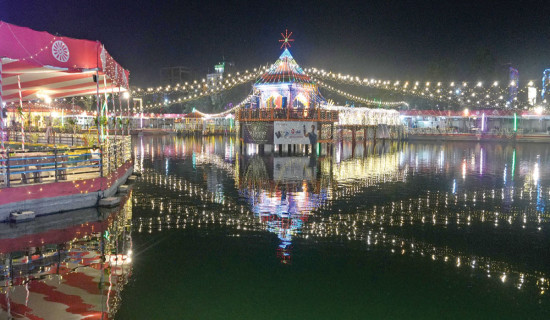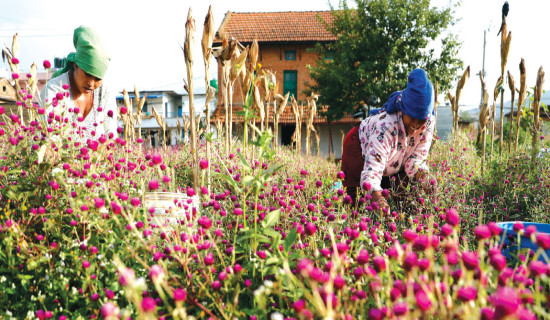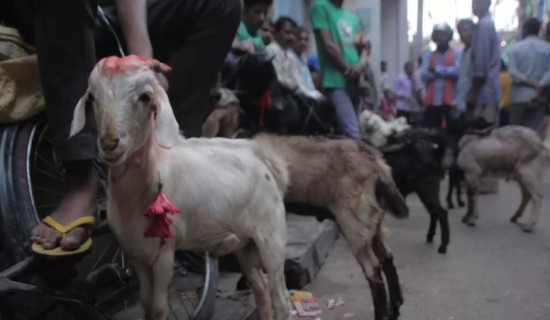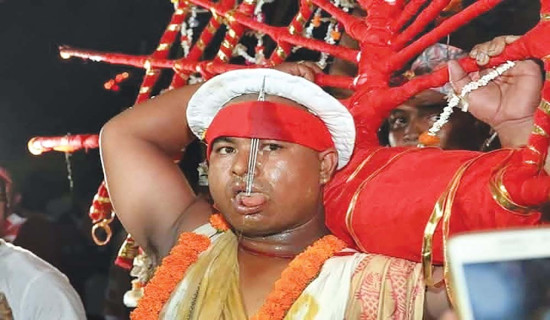- Monday, 5 January 2026
Locals unite to protect Nil Barahi Temple
Kathmandu, July 28: Neither a festival nor a celebration, yet for the past 11 weeks, a large number of people have been gathering daily - particularly on Saturdays - to contribute voluntary labour for the protection of the Nil Barahi Temple premises and the surrounding forest area from soil erosion.
Nil Barahi Temple is located in the northern area of the historical city of Tigani. It is located away from the hustle and bustle of the city in a peaceful environment.
The local residents of Tigani have taken the initiative to protect the historical Nil Barahi Temple, which is in danger due to increasing soil erosion.
An initiative was launched 11 weeks ago under the leadership of local youth to protect the Nil Barahi area located in Ward No. 9 of Madhyapur Thimi Municipality. The eleventh week of the volunteer labour campaign, which concluded on Saturday, saw encouraging participation from hundreds of locals, volunteers, and devotees.
Dil Krishna Rajbahak, President of the Shri Nil Barahi Area Conservation Concern Committee, said that the enthusiasm of the participants in the campaign is truly inspiring, seeing a large number of participants, including women, children, and elderly people.
The truly inspiring thing is that a 94-year-old citizen from Bhaktapur participated in yesterday’s 11th-week campaign to distribute water. In addition to providing voluntary labour, elderly citizens and single women also donated their allowance. "That is a huge inspiration for our committee to continue this campaign to the end," he said.
Not only are people providing voluntary labour, but people from several parts of the nation and Nepalese living abroad have also been supporting us by donating money in the name of their parents and themselves. Some people even donated without disclosing their identity, he said.
Rajbahak said, “After nearly a decade of local government's neglect, the citizens’ campaign has now taken the form of a extensive movement. So far, more than Rs. 12.3 million have been raised in just 11 weeks, and over 35,000 people have contributed their labour.”
Initially limited to a few hundred volunteers, the campaign ran every day of the week until the 8th week. After that, the volunteer days were fixed to Mondays, Wednesdays, and Saturdays to manage the crowd, which had reached three to four thousand participants in a single day. The volunteer labour campaign began on May 16, 2025, after the committee was formed, he added.
Of the collected donations, Rs. 5.5 million have been invested so far in diesel, vehicle charges, and other expenses. Currently, two excavators, one JCB, and 18 to 20 mud-carrying vehicles have been working daily to build a road to reach the Nil Barahi Temple, which was damaged due to continuous landslip over the past decade, he informed.
To build the road, the necessary soil is being carried from the Ramthali, Saraswati area of Changunarayan Municipality-1 from individual landowners. A small hill of around 10 to 12 ropanis of land was provided to the committee to carry mud and fill the landslide area for road construction.
Due to regular landslides, the road that connected the temple had completely disappeared and was very difficult to walk on. Landslides occurred at 13 places along the 800 to 900-metre road section. Now, the committee has been working on this section and is nearing the completion of mud-filling close to the temple, he informed.
After the completion of the mud-filling task, construction work will begin on an environmentally friendly toe wall using bamboo and soil-filled bags. A reinforced concrete wall will also be built at the lower section to strengthen the structure, and saplings will be planted, he added.
The Nil Barahi forest area, which was reported to cover more than 500 ropanis of land in 1994/95 (2051/52 BS) when the Nil Barahi Forest Consumer Committee was formed, has now lost around 160 ropanis. The committee plans to identify and reclaim the lost land, map the protected area, and develop the site as a daytime hiking destination, he shared as the committee’s dream plan.
Anish Baidya, the secretary of the Committee, stated that the site holds immense religious, cultural, and environmental significance. However, the increasing risk of landslides from all directions has endangered the very existence of this historical heritage, situated on a small hill.
To address this threat, participants in the ongoing campaign have been voluntarily engaging in a range of conservation activities. These include laying stones, improving water drainage systems, filling soil bags for landslide prevention, constructing embankments, and planting grass on slide-prone slopes. Additionally, volunteers are contributing to crowd management efforts by setting up help desks at key locations and using microphones for effective coordination.
This temple is not only the centre of faith for the residents of Madhyapur Thimi but also for the Newar community of the entire Kathmandu Valley. Despite the municipality claiming to have put forward a plan worth millions, there has been no work for years, prompting citizens to take the initiative for its preservation.
History of Nil Barahi Nil Barahi, established by King Bishnu Gupta, is located in Tigani of Madhyapur Municipality in the Bhaktapur district. A fair is held on the day of Dashain, and special worship is also conducted on the day of Biska Jatra.
Unlike other temples, this temple does not have a pinnacle. The temple is covered by a serpent's hood and has sattals on all four sides.
The people of the valley worship Nil Bahari as the goddess of wealth, also known as Dhana Barahi. It is believed that worshiping this goddess prevents the lack of wealth and property.




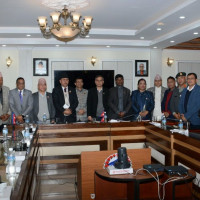
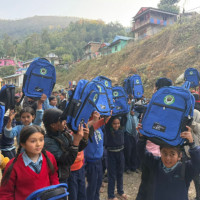
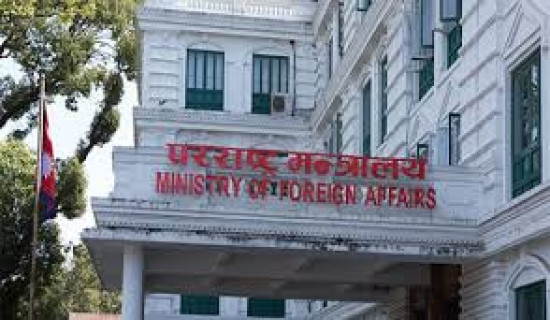

-square-thumb.jpg)


